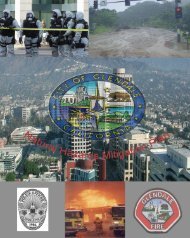Sayre Report - Hazard Mitigation Web Portal - State of California
Sayre Report - Hazard Mitigation Web Portal - State of California
Sayre Report - Hazard Mitigation Web Portal - State of California
You also want an ePaper? Increase the reach of your titles
YUMPU automatically turns print PDFs into web optimized ePapers that Google loves.
The VARs considered in this assessment include the possible loss <strong>of</strong> life and property<br />
due to landsliding, debris flow, rock fall, debris flow, mud torrents, and flooding from<br />
increased surface water run<strong>of</strong>f. In general, only 2 sites (Pacoima Dam Office Building<br />
and Reservoir) were found at risk from the direct geologic impacts <strong>of</strong> rock fall and<br />
slides, and 26 sites (chiefly the dam reservoir and debris basins) from debris flow or<br />
mud torrent flood inundation. The potential for these processes to be exacerbated by<br />
fire is primarily dependent upon burn severity and slope steepness, both <strong>of</strong> which are<br />
highly variable in the <strong>Sayre</strong> Fire area.<br />
Treatments to Mitigate the Emergency<br />
o<br />
o<br />
o<br />
Pacoima Dam Office Building<br />
• Mitigate rock fall to protect life and property.<br />
Pacoima Dam Reservoir<br />
• <strong>Mitigation</strong> <strong>of</strong> slopes is not considered economically feasible.<br />
• Restore and maintain reservoir capacity and function by removal <strong>of</strong><br />
sediment load.<br />
Other debris basins<br />
• <strong>Mitigation</strong> <strong>of</strong> the debris flow, mud torrents, flood waters into and<br />
overtopping the basins is paramount to reduce the potential loss <strong>of</strong><br />
property. This can be accomplished by monitoring and maintaining<br />
the debris basins. The potential loss <strong>of</strong> life is minimal due to the<br />
ability to evacuate when necessary by elevated public awareness<br />
and early warning <strong>of</strong> pending events.<br />
The site-specific observations included with the Technical Specialist Geology report<br />
should be considered in any emergency response plan develop by the local emergency<br />
agencies and stakeholders. Each area should undergo a more thorough analysis by a<br />
suitable licensed pr<strong>of</strong>essional to address the specific hazard(s).<br />
Hydrology<br />
The <strong>Sayre</strong> Fire consumed large areas <strong>of</strong> vegetative material and large woody debris in<br />
multiple watersheds. The Soils Burn Severity Map indicates that 24% <strong>of</strong> the area burned<br />
at a low level and 60% at moderate level and only less than 1% at high level. The<br />
hydrophobicity tests ranged from low to moderate with small patches <strong>of</strong> high confirming<br />
the burn severity map.<br />
Peak flows equivalent to 193% to 243% pre-fire peak flow for a 2- year storm event<br />
were estimated on drainage areas <strong>of</strong> major the debris basins and for the Pacoima<br />
reservoir. The sediment loads on all debris basins were estimated to be comparable to<br />
their maximum capacity; at Wilson, May-1 and Sombrero debris basins, there is a 2-5%<br />
probability that their maximum capacity would be exceeded.<br />
Evaluations <strong>of</strong> the major debris basins in the area indicate some initial signs <strong>of</strong> sediment<br />
build up. The Pacoima reservoir has high risk <strong>of</strong> sediment build up, and the inlet/outlet

















